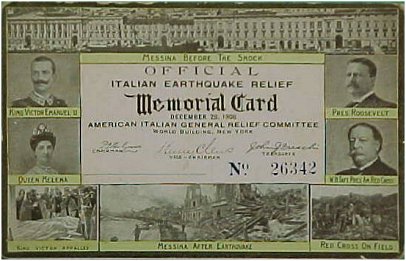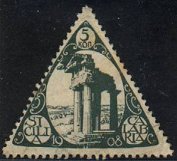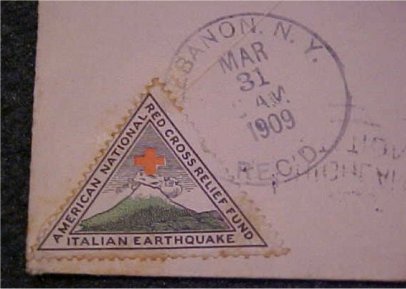
The Second Theory
The Second Theory
Relief Aid - The Second Theory.The second historical event that has drawn the attention of researchers in their attempt to authenticate the $3,000,000 American Gold Eagle shipment was the significant relief effort that had developed for the earthquake victims at Messina, Italy, and the fact that the REPUBLIC had a port of call at Naples, the staging area for the relief effort. The earthquakes had killed over 100,000 people and left an additional 200,000 homeless. Could the gold shipment have been allotted for earthquake relief as has been suggested by other secondary sources? International Relief
US Charitable ContributionsThe Red Cross Appeal Miss Catherine S. Leverich, secretary of the New York County sub-division of the Red Cross, issued a statement last night telling of the advantages of making contributions through that body. The statement read:
NY Tribune, January 1, 09, 3:1
New York Times, January 3, 1909, p. 10 US Government Relief FundsWASHINGTON, January 18 - ... At the cabinet meeting [January 17] Secretary Newberry was instructed by President Roosevelt to spend $500,000 in purchasing all articles necessary for the building of houses [in the earthquake area of Italy]. ... Pay Director Mudd, who is in charge of the naval pay office in New York, will have charge of the chartering and loading of the vessels. [Emphasis supplied. Pay Director Mudd, of course, would also be responsible for the delivery of Navy monies.] It is expected that practically all will be ready to leave New York before the end of this week. New York Commercial, The US Congress approved the expenditure of $800,000 for the relief of sufferers from earthquake in Italy. The Bill originated as H. R. 24832 and was enacted into law, Public No. 184, on January 5, 1909. On January 18, 1909, the Treasury Department issued Appropriation Warrant No. 16 for $800,000 in favor of the Navy Department, the agency designated by the President to expend the relief funds. The Treasury Department was to credit its General Account of Advances, Navy Department, for $800,000 with adjustments effected through the Auditor for the Navy Department, in the same manner as for other Naval disbursements. 1 The Navy's requisitions upon the fund will receive immediate action by this [Treasury] Department when presented.2 Of the foregoing [$800,000] it is understood that three hundred thousand dollars will consist of stores and supplies from steamship CELTIC or CULGOA or other vessels now on their way to Italian waters and that five hundred thousand dollars will be paid in cash out of the United States Treasury.3 Ultimately, the $500,000 balance was earmarked for the purchase of building supplies and related expenses in the shipment and construction of shelters. The Fleet expended the following values in stores directly to the Italian earthquake survivors:
Therefore, the Fleet could receive this amount as reimbursement for the supplies it had provided through its relief effort. Of this amount, the Company has not yet identified the proportions paid to the Fleet in cash monies, if any, (and if paid in cash, how those funds were shipped to the Fleet) and/or simply credited to the Fleet through bookkeeping adjustments. We do know, however, that as of January 18, 1909, the $800,000 was immediately available to the Navy. Funds DisbursementsROME, January 21 - The gravest problem which Italy now faces is that of providing for the 200,000 made homeless by the recent earthquake, who were scattered throughout Sicily and Calabria and congregated in Naples. Their support is costing approximately $100,000 a day; an enormous sum, which neither charity nor the resources of the state can bear for any length of time.... New York Post, January 21, 09, 1:4 AND after the REPUBLIC sinks: LONDON, January 28 - According to the Rome correspondent of the Times, although a month has elapsed there are still many earthquake devastated villages in Calabria which have received no relief at all. Even in Reggio and Messina part of the population is yet only half clothed and scantily fed. The public officials are blameless, but the matter effects the administration of the private charity so generously given by Italy and other countries. The central relief fund exceeds $3,000,000. No account has been given lately of its expenditure, which, however, has been relatively small. ... New York Sun, January 29, 09, 1:6 The loss of relief funds aboard the REPUBLIC has positive support; this rumor, too, originated at the time of the REPUBLIC's loss: New York American, January 25, 1909, 2:7 Reports that the REPUBLIC carried a large sum of money collected for the sufferers from the earthquake at Messina were denied yesterday at the offices of the White Star Line. At least Manager Mitchell of the Mediterranean Service said that no such [our emphasis added] money had been turned over to the steamship company for transportation; it was of course possible, Mr. Mitchell said, that some individual passenger had such a treasure in his personal belongings. N. Y. Sun, January 25, 09, 2:2 A thorough examination of the "Relief" theory as a possible explanation for a gold cargo indicates the following:
Therefore, it is unlikely that the $3,000,000 rumor could be attributable to a single or even combined relief shipment(s). The First Two Theories - Summary.If the REPUBLIC did carry a $3,000,000 American Gold Eagle shipment, investigation to authenticate this rumored shipment would be conducted in one or both of the above areas. A thorough investigation - which could entail years of research into just these two theories - would indicate that, although the REPUBLIC may have some funds aboard for Italian relief, especially among the passengers,6 and additional funds for the Battleship Fleet for either payroll and/or operating expenses (Mr. Connolly's $250,000, above quote, is more appropriate than $3,000,000), neither theory can support the existence of the REPUBLIC's legendary, yet specifically defined, treasure. The Navy Payroll and Relief Shipment theories probably developed naturally. If, indeed, a $3,000,000 American Gold Eagle shipment was lost with the REPUBLIC and if this fact was somehow disclosed, but without further elaboration, rumors would fill the vacuum. Fact would mix with conjecture. The rumors would associate the known fact - the 3 million dollar American Gold Eagle shipment - in some fashion with other known facts: the REPUBLIC's known and publicized destinations, passengers, cargos, and shipment consignees. Or, the Navy Payroll theory may have originated within the US Navy Fleet itself. If the Fleet's sailors had not been paid at Gibraltar - sailors would certainly remember not being paid, they may have attributed (officially or not) that omission as a consequence of the REPUBLIC's loss. See: Other Cargos and Footnote 2 at that location. However, once in circulation, the lives of the Navy Payroll and Relief Shipment theories may have been deliberately nourished in order to assist in the concealment of the loss of a more sensitive cargo. False rumors that contain a kernel of truth are more credible, and more difficult to disprove - but, if kept in the public's consciousness, are designed to be actually dissuasive simply because, in order to be proved or disproved, they'll require further investigation. When submitted to critical examination (after the mis-directed expenditure of often significant time and resources), false rumors will ultimately - and certainly - collapse. When that happens, the kernel of "true" fact contained within the false rumor will be assumed to be also false. For example, in their research of the REPUBLIC, prior to Captain Bayerle's work, all other researchers (and there had been hundreds) had come to the following uniform, but illogical, conclusion: "There is no $3 million newly-minted American Gold Eagle US Navy Payroll and there is no $3 million newly-minted American Gold Eagle Relief Shipment. Therefore, there is no gold aboard the REPUBLIC." Such rumors are dis-informative; they raise a significant impediment to the discovery of truth. An in-depth analysis of financial sources precipitates a third, heretofore untraveled, avenue of research. Captain Bayerle uncovers the necessary facts which support the existence of the legendary treasure, substantiating a $3,000,000 mint-condition American Gold Eagle coin shipment loss aboard the REPUBLIC - Captain Bayerle's Third TheoryTM, the Tsar's Gold. |
||||||||||||||||
FOOTNOTES1 Secretary of the Navy to the President, Navy Department letter dated January 18, 1909, NARA, RG 80, File 27162-10, and Note attached to Treasury Warrant No. 16, NARA, RG 80, File 27162. |
||||||||||||||||



